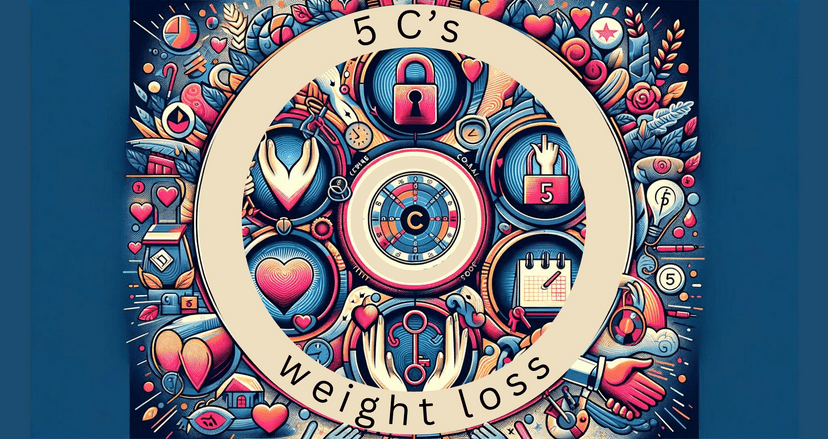What is the 8 Second Rule for Weight Loss?

Introduction to the 8 Second Rule
In our quest for health and fitness, we often discover innovative methods to shed those extra pounds. Among the cluster of dietary plans and workout regimes that promise weight loss, the 8 Second Rule stands out due to its unique nature. It may seem minimalist, yet its effectiveness in promoting weight loss has garnered attention from nutrition experts, behaviour scientists, and fitness enthusiasts alike.
Unlike conventional weight loss paradigms, the 8 Second Rule advocates a mindful eating technique that focuses more on the 'how' than the 'what.' Instead of dictating the type of food you should consume, it emphasizes your eating pattern. The core premise is to take an 8-second pause before starting to eat, thus promoting portion control and potentially reducing your overall calorie intake.
The 8 Second Rule isn't just a diet plan to follow; it's a behavioural modification approach towards eating, which intends to establish a healthier relationship between you and your meals.
Origins and Overview of the 8 Second Rule
The 8 Second Rule stems from the principles of mindful eating. Rooted in Buddhist teachings, mindful eating encourages increased awareness of physical and emotional sensations associated with eating. It urges us to savour the moment and the meal before us rather than simply consuming it without consideration.
By taking an 8 second pause before we start eating, we consciously reduce the pace of our meal, helping us to become more aware of our satiety cues. This leads to better portion control, a known technique to manage calorie intake without necessarily disrupting the composition of our meals.
The 8 Second Rule utilises this principle of mindful eating to our benefit by incorporating a simple yet effective pause in our meals. This pause provides us with a moment to reflect on our necessity for the meal, our hunger cues, and aligns us with the purpose of the meal, fostering healthier eating habits and facilitating weight loss.
How It Aims to Promote Weight Loss
The 8 Second Rule, by instilling mindful eating habits, helps us to listen to our body's natural signals for hunger and fullness. By taking a pause before beginning your meal, you allow your body time to activate its satiety signals.
This not only reduces the chance of overeating but also promotes healthier eating habits, enhancing the effectiveness of weight management strategies without the necessity for drastic dietary modifications or rigorous workout plans. Essentially, the aim is to switch from eating due to emotional triggers or out of boredom to eating only when you're genuinely hungry.
Mindful Eating vs. Mindless Eating
The context of the 8 Second Rule comes to life when we understand the difference between mindful eating and mindless eating. Mindless eating is when we eat without paying attention to what and how much we're eating. It often results from eating while distracted, leading to overconsumption and potential weight gain.
On the other hand, mindful eating encourages us to slow down and pay attention to our food, savouring every bite and being aware of each mouthful. It helps us to recognize natural hunger and fullness cues and fosters a healthier relationship with food. The 8 Second Rule is a mindful eating technique tailored to address the unconscious eating patterns often leading to weight gain.
Benefits of Implementing the 8 Second Rule
Implementing the 8 Second Rule inevitably unveils a plethora of health and wellness benefits. Among these are a tangible improvement in digestion and satiety, a measured encouragement for a mindful relationship with food, and a substantial contribution to sustainable weight management. Curious? Let's delve deeper into these advantages to truly appreciate how this simple rule can bring about remarkable changes in your pursuit of weight loss and overall well-being.
Improving Digestion and Satiety
The initiation of the digestive process starts not in your stomach, but in your mouth. Chewing slowly and thoroughly - for about eight seconds per bite - allows your food to mix well with your saliva, beginning the breakdown of complex carbohydrates. This in turn eases the burden on your stomach, leading to more efficient digestion and absorption.
Slowing down also allows your brain ample time to receive the 'fullness signal' from your stomach before you consume more food than necessary. This significantly enhances satiety, hence reducing caloric intake at mealtime. We can utilize this fact in our efforts for weight loss. By giving the digestion process a head start and increasing feelings of fullness, we can drastically cut down total calorie consumption and subsequently achieve weight loss.
Encouraging a Mindful Relationship with Food
The practice of eating slowly is a fundamental trait of mindful eating, a concept that fosters a balanced and respectful relationship with food. Evidence suggests that mindful eating discourages overeating and binge behaviors, which are second reasons behind weight gain and obesity.
The 8 second rule pushes you to pay more attention to the food you're eating, savoring every bite, noticing its textures and flavors, and expressing gratitude for the nourishment it provides. Consequently, food becomes more satisfying, and the 'need' for more decreases; discouraging overeating and reducing the likelihood of weight gain.
Contributions to Sustainable Weight Management
Perhaps one of the most compelling reasons to adopt the 8 second rule is for its contribution to sustainable weight management. Weight loss methods are often centered around fad diets or intense workout regimens which can be hard to uphold in the long run. Such practices often lead to the cyclical pattern of weight loss and gain known as "yo-yo dieting", which can harm your metabolism and overall health.
In contrast, the 8 second rule is a simple, doable, and sustainable approach that you can incorporate into your eating habits for a lifetime. The potential results are not dazzlingly quick weight loss, but gradual and consistent weight reduction over time, leading to the eventual achievement of a healthier body and state of mind. Moreover, it encourages a healthier relationship with food, helping you break free from negative eating behaviors. Thus, the 8 second rule could be a critical factor shaping your journey towards sustainable, long term weight management.
As we navigate through the plethora of dietary advice and weight loss trends, it's reassuring to know that sometimes it is the simplest techniques, such as the 8 second rule, that secure the most significant results. So, for those in search of sustainable weight loss strategies, taking the time to implement this practice could yield rewarding health benefits indeed!
Practical Tips for Practicing the 8 Second Rule
When considering how to incorporate the 8 second rule into your daily eating habits, it's important to have a clear understanding of the principle behind this approach. The 8 second rule is based on the concept of slowing down your eating speed, taking at least 8 seconds to chew and swallow each bite. Slower eating has been associated with improved digestion, better hydration, easier weight loss, and greater satisfaction with our meals.
Incorporating the Rule into Daily Meals
The key to implementing the 8 second rule into your daily meal structure is consistency and mindfulness. Aim to practice the following techniques:
- During every meal, focus on each bite. Pay attention to the taste, texture, and aroma of your food. Chew slowly.
- Always put your utensils down in between bites. This encourages a slower pace and grants more attention to each bite ingested.
- Prioritize sit-down meals over grabbing fast food and eating on the run. Eating while distracted often promotes quicker eating and we may digest our food less effectively.
Mindful Eating Tips for Snacks and Dining Out
When it comes to snacks and dining out, the 8 second rule can be a bit challenging but it's not impossible. It's all about being mindful and intentional. Here are some guidelines:
- Opt for snacks that require more chewing such as nuts and fruits. Remember to savour every bite.
- When dining out, be the last to start eating and avoid finishing first.
- Discourage a competitive eating atmosphere. Enjoy conversations during the meal and aim for a relaxed, leisurely dining experience.
Overcoming Challenges and Staying Consistent
It's completely normal to face challenges when trying to slow down your eating pace, especially if you're used to eating quickly. However, the key to success is persistence and consistency. Here are some tips:
- Start small. Aim to slow down one meal a day and gradually extend it to all meals.
- Keep reminders around your eating space. Post-it notes with "8 second rule" or a timer can help until this becomes natural.
- Lastly, stay patient. Change takes time but the long-term benefits for your health and weight management make the effort worth it.
Through consistent practice, the 8 second rule can become a habitual eating pattern that contributes to better digestion, controlled portion sizes, and ultimately more sustainable weight control.
In Summary
To encapsulate, we delved into the unique yet impactful 8 Second Rule. It's an approach which encourages mindful eating rather than focusing solely on diet alterations. This behaviour modification makes you conscious of your eating pattern, prompting you to take an 8-second pause before every meal. This pause allows your body to recognize its natural hunger and fullness cues, enabling portion control and preventing overeating.
Mindful eating, at the core of the 8 Second Rule, is a potent contrast to mindless eating, which is eating incognizant of the quantity and quality of food consumed. Implementing the 8 Second Rule can significantly improve digestion and satiety, stimulate a mindful relationship with food, and contribute to sustainable weight control.
To put the 8 Second Rule into effect, it's essential to follow a plan. Start by incorporating this rule into your daily meals, and extend it to your snacks and dine-outs eventually. Begin with steps to decelerate your eating speed, favour sit-down meals, opt for chewy snacks, and foster a languid dining environment.
Overcoming challenges and adhering to the rule might require determination and patience, but by starting small, like by normalising longer chewing, and reminding yourself consistently, you are sure to cultivate a healthy, mindful eating habit eventually.
Here's your action plan to kick start this sustainable journey:
Plan of action to implement the 8 Second Rule:
-
Learn more about mindful eating, and the 8 Second Rule specifically.
-
Identify your current eating habits that may counter mindfulness (e.g., speed eating, eating while distracted, etc.)
Expedite the 8 Second Rule with these action steps:
-
Implement the 8 Second Rule in your daily eating habits, starting with one meal a day and then slowing extending to all.
-
Chew slowly, taking at least 8 seconds per bite, appreciating the taste, texture, and aroma of your food.
-
Put your utensils down between bites fostering a slower eating pace.
-
Prefer sit-down meals over fast food. Avoid eating while distracted.
-
Use the Rule while snacking and dining out. Opt for snacks that require more chewing and savour every bite.
-
Lastly, stay consistent and patient, as these changes will take time to become habitual.
By following these plans, you'll pave the way for a newfound, healthier relationship with food, improved digestion, and a sustainable approach to weight management— making every bite a conscious and gratifying experience.













